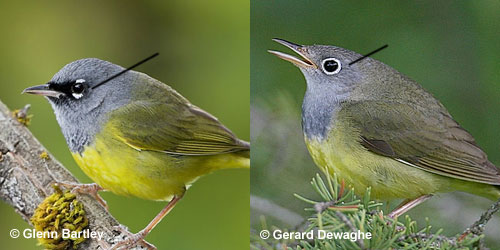
On picture: Some eye rings are faint. Other eye rings, as on these two very similar species, are quite noticeable. The broken eye ring of the MacGillivray’s Warbler (left), compared to the complete eye ring of the Connecticut Warbler (right) is a key identification mark.
Color and color patterns, both striking and subtle, are some of the most important clues in identifying a particular bird species. Here are some things to watch for.
On this page
Eye Rings
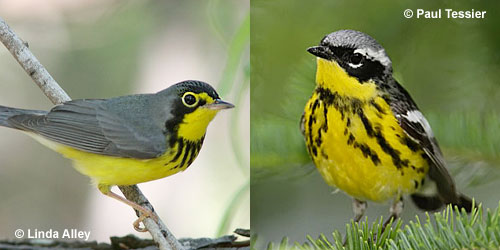
Note the yellow eye ring on the Canada Warbler (left) and the broken eye ring on the Magnolia Warbler (right)
Eye Lines and Face Patterns
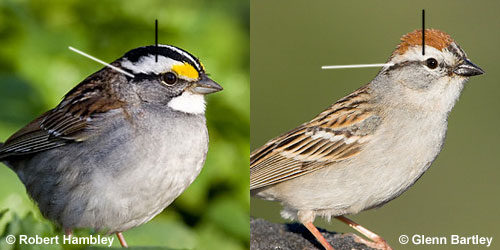
The bird on the left is a White-throated Sparrow, the one on the right is a Chipping Sparrow.
Note the dark eye line on these two sparrows. Eye lines can be a good field mark for certain species. The pale (white in the bird on the left) area above the eye line is called the eyebrow or supercilium. The area between the eye and the bill is called the lores. The bird on the left is sometimes said to have yellow lores, but the area is more specifically referred to as supraloral.
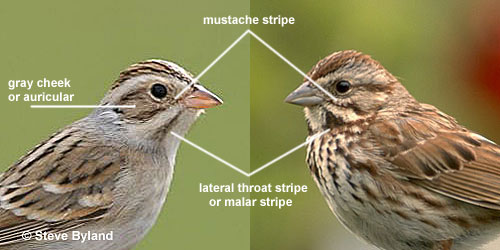
Subtle face patterns are often clues to sparrow identification. The gray-brown cheek patch on the Clay-colored Sparrow (left) is an important identifying mark. The Song Sparrow (right) is one of our most common and wide-spread sparrows.
Crown Stripes
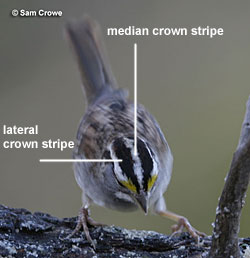
Crown stripes are sometimes a useful field mark but are often hard to see. This White-throated Sparrow has well-defined crown stripes. The area on the top of the head is often referred to as the cap or crown.
Throat, Chest, Belly and Flanks
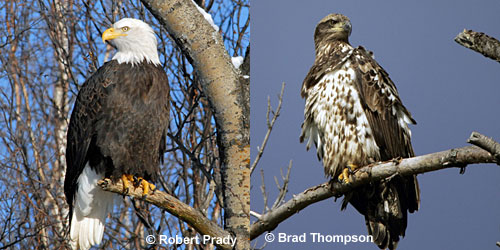
Bald Eagle – adult on the left, sub-adult on the right.
Colors and patterns on the throat, chest, belly and flanks are often some of the most noticeable. Both of these thrushes could be described as brown birds with spots on the chest and belly. The spots on the Wood Thrush (right) are more distinct and appear to be present well into the belly region. The Swainson’s Thrush (left) exhibits light tan flanks, compared to the cleaner appearance of the Wood Thrush.
Under-tail Coverts
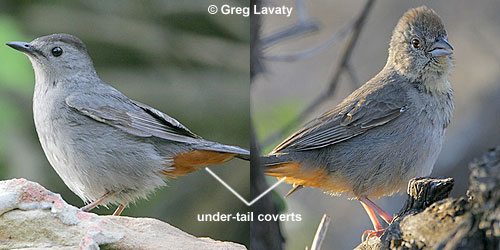
The under-tail coverts on some species is a distinctive color. The area is often referred to as the crissum, although technically the crissum is the area around the vent (cloacal opening), in front of the under-tail coverts. The bird on the left is a Gray Catbird, the one on the right is a Canyon Towhee.
Back and Wings

A bird’s back and wings are often darker than the bird’s underparts. When identifying a new bird, check for the color of the back, the presence or absence of wing bars and the color of the shoulder. The Baltimore Oriole (left) is generally a more eastern species, while the Bullock’s Oriole (right) is a more western species. At one time they were considered the same species – the Northern Oriole.
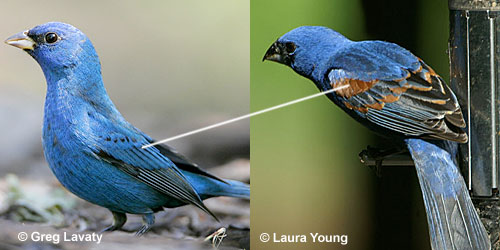
Compare the wings and wing bars of the Indigo Bunting (left) and Blue Grosbeak (right).
Sexual Dimorphism
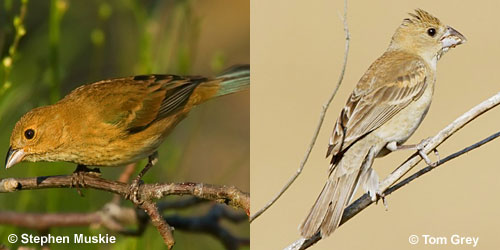
The term sexual dimorphism is just a fancy way of saying males and females of the same species do not have the same plumage. Compare the female Indigo Bunting (left) and female Blue Grosbeak (right) with their male counterparts in the image above.
Ducks are well-known for exhibiting a high degree of sexual dimorphism. In other species (such as most jays, gulls and terns) there is no difference in the appearance of the males and females.
Molting Patterns

Bald Eagle – adult on the left, sub-adult on the right.
Oh boy, here’s a complicated topic – molting. A bird’s plumage (color) may change from year to year or season to season. Or not.
As briefly as possible, here are some of the basics.
– In some species, first year birds look like adults at the end of their first summer (Blue Jay).
– Some species may require 2, 3, 4 or even 5 years (Bald Eagle) to reach full, adult plumage.
– Some birds have the same appearance throughout the year (chickadees), while others sport one plumage in the spring and a different one in the winter (American Goldfinch).
These changes in color and overall appearance are the result of a complex pattern of feather replacement called molting. Molting patterns can vary by species and, to some extent, even within the same species.
Birds molt to replace worn feathers. In general, birds go through one of these three molting patterns.
– All feathers are replaced once a year.
– One complete molt each year, followed by a partial molt. The partial molt is often to replace wing weathers, which are subject to the most wear.
– Two complete molts each year.
The males of many species have a bright, colorful plumage in the spring, followed by a more subdued color in the fall and winter. It is thought the production of the less colorful feathers reduces the energy drain on a bird’s system, and makes the bird less conspicuous to predators. A spring molt brings back the bright colors, just in time to attract a mate.
You may also hear different names applied to the same plumage stage. Here are the common equivalents.
Spring/summer = breeding = alternate
Fall/winter = non-breeding = basic
The terms alternate and basic are often used by more advanced birders and scientists.
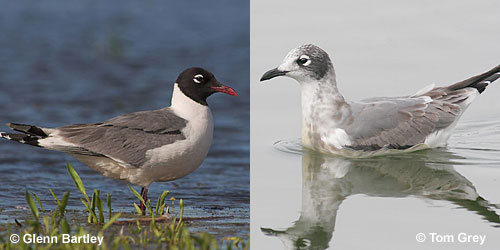
Franklin’s Gull in breeding (alternate) plumage left, and in non-breeding (basic) plumage on the right.
Fun Facts
The colors in most bird feathers are the result of different pigments. Melanin, for example, produces black feathers.
Some colors are the result of the structure of a bird’s feathers. This includes the gorget (throat) of hummingbirds, and surprisingly the blue colors in the feathers of a Blue Jay.
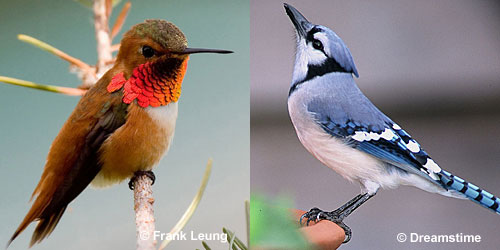
The shimmering colors of a hummingbird’s gorget and the blue color in the feathers of a Blue Jay are both created by the refraction of light. The bird on the left is a Rufous Hummingbird.

